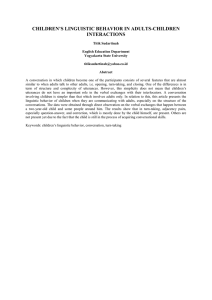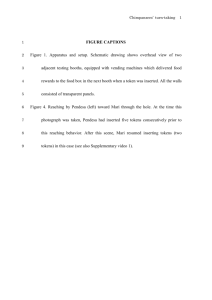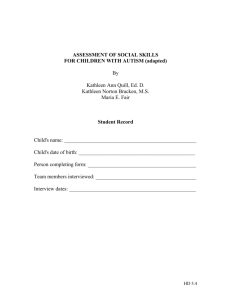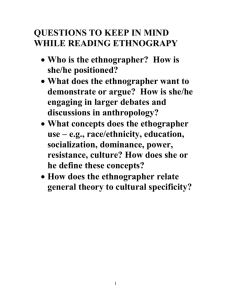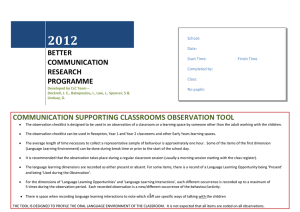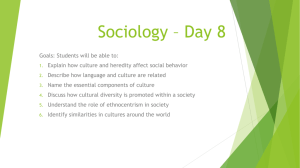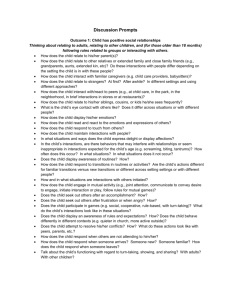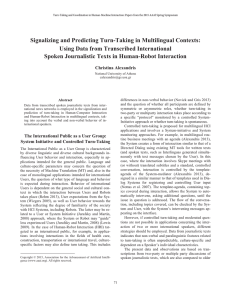Recognizing Continuous Social Engagement Level in Dyadic Conversation by
advertisement
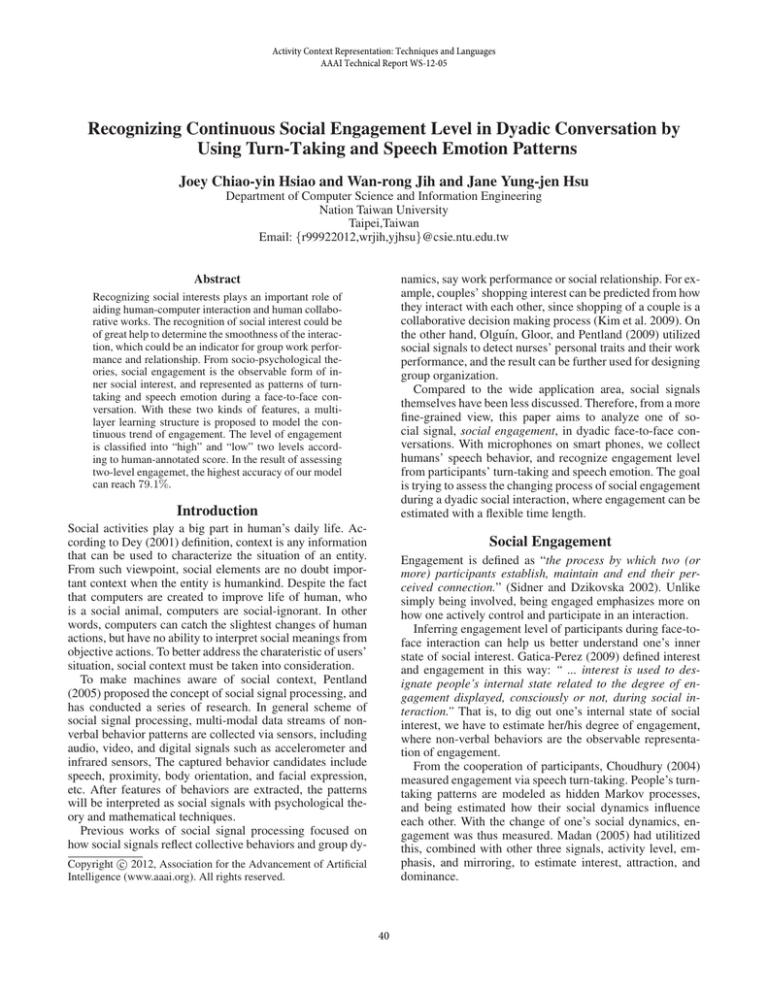
Activity Context Representation: Techniques and Languages
AAAI Technical Report WS-12-05
Recognizing Continuous Social Engagement Level in Dyadic Conversation by
Using Turn-Taking and Speech Emotion Patterns
Joey Chiao-yin Hsiao and Wan-rong Jih and Jane Yung-jen Hsu
Department of Computer Science and Information Engineering
Nation Taiwan University
Taipei,Taiwan
Email: {r99922012,wrjih,yjhsu}@csie.ntu.edu.tw
Abstract
namics, say work performance or social relationship. For example, couples’ shopping interest can be predicted from how
they interact with each other, since shopping of a couple is a
collaborative decision making process (Kim et al. 2009). On
the other hand, Olguı́n, Gloor, and Pentland (2009) utilized
social signals to detect nurses’ personal traits and their work
performance, and the result can be further used for designing
group organization.
Compared to the wide application area, social signals
themselves have been less discussed. Therefore, from a more
fine-grained view, this paper aims to analyze one of social signal, social engagement, in dyadic face-to-face conversations. With microphones on smart phones, we collect
humans’ speech behavior, and recognize engagement level
from participants’ turn-taking and speech emotion. The goal
is trying to assess the changing process of social engagement
during a dyadic social interaction, where engagement can be
estimated with a flexible time length.
Recognizing social interests plays an important role of
aiding human-computer interaction and human collaborative works. The recognition of social interest could be
of great help to determine the smoothness of the interaction, which could be an indicator for group work performance and relationship. From socio-psychological theories, social engagement is the observable form of inner social interest, and represented as patterns of turntaking and speech emotion during a face-to-face conversation. With these two kinds of features, a multilayer learning structure is proposed to model the continuous trend of engagement. The level of engagement
is classified into “high” and “low” two levels according to human-annotated score. In the result of assessing
two-level engagemet, the highest accuracy of our model
can reach 79.1%.
Introduction
Social activities play a big part in human’s daily life. According to Dey (2001) definition, context is any information
that can be used to characterize the situation of an entity.
From such viewpoint, social elements are no doubt important context when the entity is humankind. Despite the fact
that computers are created to improve life of human, who
is a social animal, computers are social-ignorant. In other
words, computers can catch the slightest changes of human
actions, but have no ability to interpret social meanings from
objective actions. To better address the charateristic of users’
situation, social context must be taken into consideration.
To make machines aware of social context, Pentland
(2005) proposed the concept of social signal processing, and
has conducted a series of research. In general scheme of
social signal processing, multi-modal data streams of nonverbal behavior patterns are collected via sensors, including
audio, video, and digital signals such as accelerometer and
infrared sensors, The captured behavior candidates include
speech, proximity, body orientation, and facial expression,
etc. After features of behaviors are extracted, the patterns
will be interpreted as social signals with psychological theory and mathematical techniques.
Previous works of social signal processing focused on
how social signals reflect collective behaviors and group dy-
Social Engagement
Engagement is defined as “the process by which two (or
more) participants establish, maintain and end their perceived connection.” (Sidner and Dzikovska 2002). Unlike
simply being involved, being engaged emphasizes more on
how one actively control and participate in an interaction.
Inferring engagement level of participants during face-toface interaction can help us better understand one’s inner
state of social interest. Gatica-Perez (2009) defined interest
and engagement in this way: “ ... interest is used to designate people’s internal state related to the degree of engagement displayed, consciously or not, during social interaction.” That is, to dig out one’s internal state of social
interest, we have to estimate her/his degree of engagement,
where non-verbal behaviors are the observable representation of engagement.
From the cooperation of participants, Choudhury (2004)
measured engagement via speech turn-taking. People’s turntaking patterns are modeled as hidden Markov processes,
and being estimated how their social dynamics influence
each other. With the change of one’s social dynamics, engagement was thus measured. Madan (2005) had utilitized
this, combined with other three signals, activity level, emphasis, and mirroring, to estimate interest, attraction, and
dominance.
c 2012, Association for the Advancement of Artificial
Copyright Intelligence (www.aaai.org). All rights reserved.
40
On the other hand, engagement is also conisdered as an
presentation of personal emotion (Goodwin and Goodwin
2000). Yu, Aoki, and Woodruff (2004) analyzed engagement
in coversations on telephone with this idea. They first classify speech emotion in utterance level with Support Vector
Machine (SVM), and use the classified emotions as observation in Coupled Hidden Markov Model (CHMM).
Methodology
To maintain stationary property of audio signals, audio features need to be extracted within a tiny window, i.e. 1/32
second in our experiment. However, human’s social and
emotion state lasts for seconds, minutes, or even longer. To
recognize human’s social engagement, what we need is a set
of features in a bigger scale, which is capable to capture behavior change tendency. Therefore, instead of directly learning from low-level acoustic features, we propose a multilayer learning structure to summarize them into high-level
features presenting humans’ behavior.
The model structure is showed in Figure 1. The three layers provide features of different scale respectively. The lowlevel features are directly extracted from raw audio data, and
then used for generating mid-level features by using several statistical funcitons within a one second sliding window.
The kinds of functions and length of window varies with the
high-level features we want to extract. The high-level features are extracted with more sophisticated methods. Coupled Hidden Markov Model (CHMM) and K-means algorithm are used to recognize patterns in mid-level feature set,
and high-level feature set will be extracted from the output
of CHMM and K-means algorithm.
Figure 1: The hierarchical model of assessing social engagement.
Low-level and Mid-level Feature Extraction
In widely accepted definition, turn is a shared and limited resource, only one can have turn and speak in one time
(Sacks, Schegloff, and Jefferson 1974). In every time slice,
current speaker evaluates, consciously or nonconsiously, for
keeping the turn or giving it up. On the other hand, a listener
becomes a speaker when being assigned by current speaker
or self-select (may be interruption) to take turn.
No doubt, in reality conversation goes further complicated. People use multimodal channel to commnicate and
speech overlapping always happens. Kinds of models and
behaviors are proposed to further clarify human conversation. To simplify the problem here, we defined that a turn is
taken by one who starts speaking when no one speaks. Even
her/his interacting partner starts speaking, current speaker
holds turn until stopping.
CHMM is used to decode turn-taking sequences, for modeling mutual effect between paticipants. We used the features introduced by Basu (2002). For each kind of attribute,
the mean value within a second is used, including: volume, maximum value of non-initial auto-correlation, number of peaks of auto-correlation, and spectral entropy, and
six derivative features generated from the four features.
In the lowest layer, features are extracted from raw audio
wave files. The audio format is 8-bit encoded wave file,
sampled in 8kHz. Low-level audio features are extracted
within a frame containing 250 samples, i.e. 31.25ms, where
125 overlapped samples with previous frame. As a result,
within one second, there will be 64 low-level feature vectors,
which contains following features: volume (log energy of
signal), pitch, fundamental frequency, zero-crossing rate of
signal, maximum value of non-initial auto-correlation peaks,
amount of non-initial auto-correlation peaks, spectral entropy, mel frequency cepstral coefficients (MFCC).
In the mid-level, low-level features within a 1-second sliding window are crossed with several mathematical functions, e.g. mean, standard deviation, and derivation, to generate a new set of features.
Turn-taking Recognition
Turn-taking behaviors have been considered an observable
presentation of one’s social attitude. How one organizes
her/his turn-taking structure is resulted from how she/he participates in the interaction and the relation between the interlocutor (Goodwin and Goodwin 2000). Thus we want to
decode turn-taking sequences from mid-level features, and
apply statistical functions on the sequences to get attributes
of turn-taking.
Acoustic Pattern Clustering
In addition to turn-taking patterns, we hope to model engagement from personal emotion. However, one challenge
41
attempt to catch more information by taking turn-taking patterns into consideration, giving more possibility in addition
to only using emotion.
of speech emotion recognition is the exhausting work of annotating. Instead of annotating emotions, we choose a simpler way, by only clustering the acoustic features which are
widely used in speech emption recognition.
The low-level features used here include: volume, pitch,
fundamental frequency, MFCC, and zero-crossing rate of
signals. Ten mathematical functions are then applied to
the low-level features within an 1-second sliding window,
i.e. 32 instances, including: mean, standard deviation, variance, max, min, range (i.e. max-min), skew, kurtosis, zerocrossing rate, and mean of absolute value. Eventually, every
mid-level vector contains 170 features.
K-means clustering is then used for clustering mid-level
feature instances, where we assigned 16 clusters. The data
will then be presented as a series of cluster numbers, e.g. [2,
3, 11, 10, 9, 8, ...].
Annotation Instead of directly assigning engagement levels on silding windows, we assigned a score ranging from 1
to 4 scale on arbitrarily long periods, where 1 means strongly
disengaged and 4 as strongly engaged.
We use voting to choose score for every second. Only
when all three annotators gave different scores, the mean
score would be used. Scores within a sliding window will be
summed for the segment. For the 2-level engagement recognition, we assign the segment with score higher than mean of
all scores as high, and segment with score lower than mean
as low. By doing this way, we can have more flexibility to
choose size of sliding window in future, rather than simply
assigning a label onto a fixed length segment.
High-level Feature Extraction
Experiments and Results
High-level Features from Turn-taking We first tried to
model engagement from patterns of turn-taking. Within a
30 seconds window, high-level features of an encoded turntaking behavior series are extracted: total length of turn,
times of taking turn, mean length of turn, total length of silence, times of being silence, mean length of silence. For
each participant, sign and absolute value of derivative value
of the 6 features are further computed. Also, considering
mutual effect between speakers, sign and absolute value of
difference of the original 6 features and derivative 6 values
between 2 participants are also computed. Consequently, 42
high-level features, including 18 binary and 24 numeric features are used to present the turn-taking pattern.
Data Collection
The experiment was set in a normal office environment, the
participants were announced as being experiment participants, but daily activities in background were not resticted.
Therefore, noise in environment would also be recorded, e.g.
people’s talking sound, ambient sound, or noise of daily objects. The dataset contains 11 dyadic conversations from 9
participants, collected by two iPhone 3Gs. Totally, 308 minutes of audio files are collected. The shortest length of conversation is 10 minutes, while the longest is 16 minutes, with
overall average length is 14 minutes.
An one-minute sequence is separated into 4 segments,
with sliding window shifts 15 seconds every time, which
consequently creates total 1232 instances from 308 minutes
of audio chains. The scoring task was done by three trained
annotators independently. All 22 audio chains have been
rated by every annotator. The annotators gave scores based
on observed turn-taking behaviors and prosodic change of
speakers. 94.9% of annotation received at least two agreement from three annotators.
High-level Features from Acoustic Pattern After clustering by K-means, the mid-level features have already
turned into chains containing cluster numbers. Histogram of
16 clusters within a sliding window is used as 16 features
of the 30-second segment. In other words, similar histogram
appears when similar speech emotion is presented, and provide the model with information to recognize level of engagement.
Results of Turn-taking Recognition
To make sure the results of automatically recognized turntaking bahavior sequences are reliable, we also conducted
an experiment of turn-taking recognition.
Leave-one-sequence-out cross-validation is used to evaluate the accuracy of predicting turn-taking. The overall results of decoding the 22 chains, with 18480 seconds as total
length, an average accuracy of 82.7% is reached. The best
accuracy is 89.5% and the worst case is 73.8%. We believe
that 82.7% is an accpetable result, thus the recognized turntaking sequences can be futher used for extracting high-level
features.
Engagement Recognition
Model Description Social engagement is a state shows
how a participant is interested in current social interaction.
Involved in a social interaction, participants’ emotion and
behaviors are continuous changing states, which is a result
of partner’s previous states and her/his previous states. To
model such sequential and mutual effect of two entities,
CHMM is an appropriate candidate, which models multiple
Markov chains and take mutual effect into consideration.
Yu, Aoki, and Woodruff (2004) detected one’s social engagement level based one utterance. Different from their
work, each slice in our CHMM model is based on 30-second
sliding window instead of one utterance, trying to catch behavior changes of a bigger scale than one utterance. To better model continuous behavior within a time segment, every
segment overlaps 15 seconds with previous segment. Every
minute could thus turn into 4 segments. By doing this, we
Results of Engagement Recognition
The dataset is currently small, even leaving one sequence
for testing leads much information loss and results in unbalanced data. Hence instead of using leave-one-sequence-out
cross validation, we choose 10-fold cross-validation to evaluate power of the learned model.
42
Table 1: Overall result of 2-level engagement recognition by
using turn-taking patterns
Low
High
Precision
Low
375
94
80.0%
High
255
508
66.6%
Recall 59.5% 84.4% 71.7%
Table 3: Overall result of 2-level engagement recognition by
combining turn-taking patterns and audio patterns
Low
High
Precision
Low
441
98
81.8%
High
189
504
72.7%
Recall 70.0% 83.7% 76.7%
Table 2: Overall result of 2-level engagement recognition by
using acoustic patterns
Low
High
Precision
Low
503
130
79.5%
High
127
472
78.8%
Recall 79.8% 78.4% 79.1%
than 70%, which is a reliable result as first attempt. Since research in social psychology has proved that turn-taking behaviors are highly related to social engagement, we tend to
conclude that more sophistacated method of feature extraction and selection may help improve the results which is the
next step of this work.
To evaluate power of the model, an appropriate baseline
is necessary for comparison. In our case, data are classified
into two classes, where the amount of low engagement and
high engagement instance are 630 and 602, thus 51.1% of
accuracy, i.e. 630/1232, can be used as baseline here.
Basu, S. 2002. Conversational Scene Analysis. Ph.D. Dissertation, Massachusetts Institute of Technology.
Choudhury, T. K. 2004. Sensing and modeling human networks. Ph.D. Dissertation, Massachusetts Institute of Technology.
Dey, A. K. 2001. Understanding and using context. Personal
Ubiquitous Computing 5.
Gatica-Perez, D. 2009. Modeling interest in face-to-face
conversations from multimodal nonverbal behavior. In Thiran, J.-P.; Bourlard, H.; and Marqus, F., eds., Multimodal
Signal Processing. Academic Press.
Goodwin, M. H., and Goodwin, C. 2000. Emotion within
situated activity. In Budwig, N.; Uzgiris, I. C.; and Wertsch,
J. V., eds., Communication: An Arena of Developement.
Ablex Publishing Corporation.
Kim, T. J.; Chu, M.; Brdiczka, O.; and Begole, J. 2009. Predicting shoppers’ interest from social interactions using sociometric sensors. In Proceedings of the 27th international
conference extended abstracts on Human factors in computing systems, CHI EA ’10, 4513–4518.
Madan, A. P. 2005. Thin slices of interest. Master’s thesis,
Massachusetts Institute of Technology.
Olguı́n, D. O.; Gloor, P. A.; and Pentland, A. 2009. Capturing individual and group behavior with wearable sensors. In
Proceedings of the 2009 aaai spring symposium on human
behavior modeling, SSS ’09.
Pentland, A. 2005. Socially aware computation and communication. Computer 38:33–40.
Sacks, H.; Schegloff, E. A.; and Jefferson, G. 1974. A simplest systematics for the organization of turn-taking for conversation. Language 50(4):696–735.
Sidner, C. L., and Dzikovska, M. 2002. Human-robot interaction: Engagement between humans and robots for hosting activities. In Proceedings of the 4th IEEE International
Conference on Multimodal Interfaces, ICMI ’02, 123–128.
Yu, C.; Aoki, P. M.; and Woodruff, A. 2004. Detecting user
engagement in everyday conversations. In Proceedings of
8th International Conference on Spoken Language Processing, ICSLP ’04, 1–6.
References
Using Turn-taking Pattern Table 1 shows the results
of using turn-taking patterns to recognize the engagement
level, which provides 71.7% accuracy.
Using Acoustic Pattern As Table 2 shows, the experiment
of 2-level engagement recognition, we can reach a 79.1%
accuracy, which is the best result in our experiment.
Using Hybrid Features In addition to check the performance of each kind of feature independently, we also combined the two kinds of features to see whether they can reach
a better results together. The two kinds of features mapping
to the same time slice are concatenated together as one observation instance and then fed into CHMM. Table 3 is the
result of using hybrid features, where the accuray is 76.7%.
Summary Compared to random guess, all results provide
more than 20% accuracy, which means that the features is
useful for the problem. The results of using acoustic clusters
outperforms the one using turn-taking patterns and the one
using hybrid features. The possible explanation is that the
hitograms of acoustic clusters also contain information of
turn-taking. After computed as histograms, although temporal properties of signals are faded, the histigram still provides enough information to give the model such performance. When combined with turn-taking features, the two
kinds of features covered information of each other, and thus
no significant improvement.
Conclusion
In this paper, we presented a method to model social engagement of participants during a face-to-face conversation
under a less-controlled environment. With external sensors,
people’s nonverbal behavior, i.e. audio records in our experiment, can be collected without giving participants too much
stress. The accuracy of 2-level engagement can reach more
43
